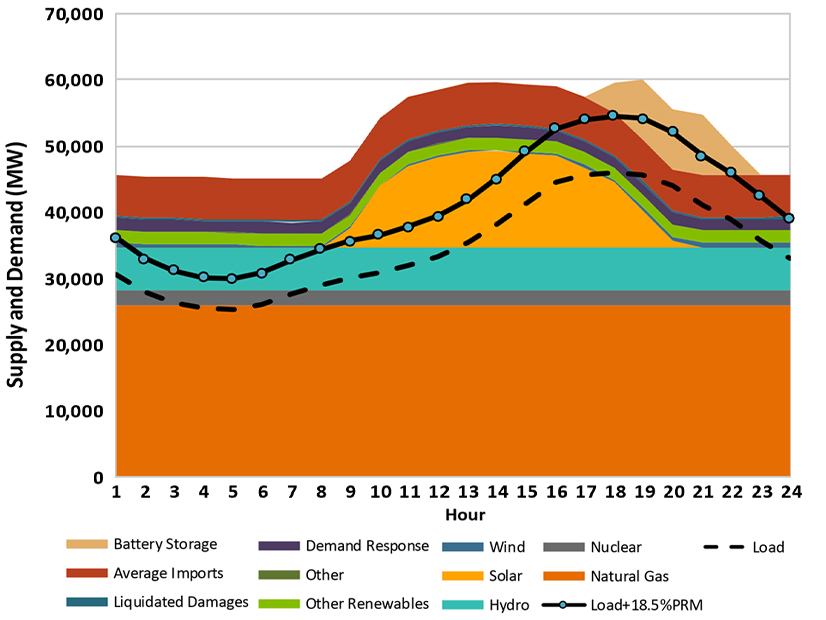
CAISO officials are optimistic about the grid’s performance this summer, as the system has added 4.5 GW of nameplate capacity since September, with an additional 4.5 GW on the way.
The figures are in CAISO’s 2024 Summer Loads and Resources Assessment released May 9.
The summer assessment found that resources expected by this summer will suffice to meet forecast demand plus an 18.5% reserve margin for June through September.
In September, when California often faces its highest demand for electricity, CAISO’s assessment showed at least 3,438 MW of capacity above the forecasted demand plus reserve margin during the 6-10 p.m. peak net load hours.
“Our findings provide a solid factual basis for going into the summer with optimism for maintaining reliability as the weather — and demand for electricity — begin to heat up between now and September and into October,” Aditya Jayam Prabhakar, CAISO director of resource assessment and planning, said in a blog post.
In addition to the resource growth, the summer 2024 demand forecast has softened, CAISO said. Hydropower conditions are expected to be “average to slightly above average” after a winter that left the state’s snowpack at 109% of the historical average.
Those factors combined will more than offset generation retirements and the transition of gas-fired generation into the state’s strategic reserves, CAISO said.
However, the summer assessment notes it doesn’t take into account “extreme events” such as wildfires or regional heat waves “that continue to pose a risk for emergency conditions to the CAISO grid.”
Two-pronged Analysis
For its analysis, CAISO used a probabilistic assessment of resources based on the California Public Utilities Commission’s February 2024 preferred system plan along with a multihour stack analysis looking at energy sufficiency on peak days during each summer month.
CAISO projected that summer peak load will be highest in July, at 46,244 MW, followed by 45,972 MW in September and 45,059 MW in August.
CAISO’s all-time high peak load was 52,061 MW on Sept. 6, 2022, at 4:58 p.m., amid an extended heat wave, the ISO reported. Rolling blackouts were narrowly averted when the Governor’s Office of Emergency Services sent out text messages urging consumers to conserve electricity. (See CAISO Reports on Summer Heat Wave Performance.)
Last summer, CAISO issued level 1 energy emergency alerts on three days in July, which were attributed to high levels of exports to the Southwest. (See CAISO DMM: High Exports to Southwest Led to July EEAs.)
Weather forecasts show that above-normal temperatures are probable across the West this summer, especially in the desert Southwest in August and September. Above-normal temperatures are less likely in coastal areas.
CAISO has access to emergency resources, the summer assessment noted.
Under the Electricity Supply Strategic Reliability Reserve Program (ESSRRP), the lifetimes of three gas-fired generating stations — Alamitos, Huntington Beach and Ormond Beach — were extended to support the grid during extreme events. Their combined capacity is about 2,859 MW.
Additional resources include the Demand Side Grid Support (DSGS) program, which the California Energy Commission launched in August 2022, and the Distributed Electricity Backup Assets (DEBA) program.
Resource Growth
From September through December, CAISO’s capacity grew by 3,576 MW, including 1,842 MW of solar and 1,321 MW of battery storage.
An additional 926 MW of capacity was added in the first three months of 2024. And from April through June, an additional 4,569 MW of capacity is expected, with 818 MW of solar and 3,199 MW of battery storage.
Gov. Gavin Newsom (D) noted battery storage’s growing role in California in a release April 25. California reached 10,379 MW of battery storage in April, up from 770 MW in 2019, Newsom’s office said.
Also during April, battery storage discharge exceeded 6,000 MW for the first time, and batteries were the largest source of grid power supply at one point during the day.
“Our energy storage revolution is here, and it couldn’t come at a more pivotal moment as we move from a grid powered by dirty fossil fuels to one powered by clean energy,” Newsom said in a statement.
